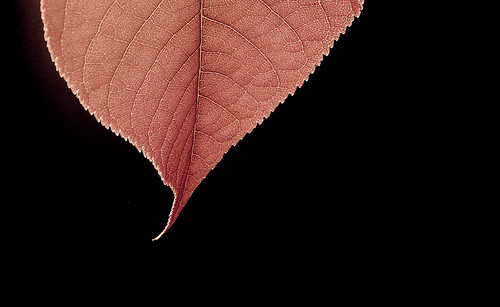
The shot above was taken on a sunny day light in my living room - how did I do it? Check out the rest of the post.
First of all - I backlit the leaf
What does that mean? It means I use a light source (a Nikon SB-600 flash) and that light source is located behind the object (the leaf). This means that the object is sandwiched between me (and the camera) and the light source. Your light source could be anything: the sun, desk lamp, flash light, TV, etc. I just happen to use my Nikon flash - plus it provides a strong enough light to overpower the ambient light - which brings us to the second point.
Secondly - overpowering the ambient
What is "ambient light"? It is the light that is around you in your current condition. So in this case, my ambient light was sun-light coming through from some windows in my house as well as the kitchen light from my left.
What does "over-powering" the ambient mean? It means that I use an external light source (my Nikon flash) to be the primary light source and rendering the ambient light to be secondary light source or to be non-existent. In this case - I want the light coming out of my flash to be the ONLY light captured by my camera in lighting the leaf and I want the background to be dark (black or close to it). So my flash needs to be my primary light source and I need to render the ambient light into close to non-existent in the final picture - thus "overpowering the ambient".
OK then - how do you overpower the ambient? It is actually quite simple: I close down the exposure enough so that when I take a picture without flash it becomes dark/black. There are a lot of combinations you can use to accomplish this among shutter speed, aperture, and ISO setting. I picked ISO 100, 1/320 and f/11. I want to close down the aperture enough to capture the detail of the leaf and since I am handholding a 200mm lens, I want high enough shutter speed (more than 1/200s) . So that means low ISO, high speed, and closed down aperture - hence I selection.
After that, I position my flash behind the leaf, put it into High-FP mode (which enable the flash to work with shutter speed higher than normal sync-speed) and put it in 1/4 power and do a test fire. Adjust the position of the flash and adjust power to 1/2 and VOILA!
I did some post-processing with the image produced: cropping (I actually captured the whole leaf), sharpening (to strengthen the detail), and manipulate the color of the leaf a little bit (it was originally yellow/orange).
I use Nikon D80 camera, Nikkor AF-S 70-200 f/2.8 VR lens, and SB-600 flash.
Wednesday, October 29, 2008
Backlighting & Overpowering Ambient
By
Johannes Setiabudi
@
5:39 PM
![]()
Subscribe to:
Post Comments (Atom)



4 comments:
so the flash is behind the leaf not in front of it? what would happen if you put the flash in the front?
If the flash is in front of the leaf (like the camera), the light will reflect the color of the leaf instead of filtered by it. What you see in the photo is the leaf acting as a light filter and the camera capturing it.
Wow, thank-you! I printed these instructions and in about an hour's worth of fooling around I was able to take a picture with an overpowered ambient.
What I learned is that while overpowering a low ambient light might be comparatively easier, it means there's less light to actually light the subject, but I eventually hit a sweet spot.
I was also able to work around having the image be badly overexposed by positioning the flash to my left, but close to the subject and dialed way down (1/64th, I think).
@nooks - well said. you gotta try it (trial and error a little bit) to get a sweet spot.
Yes, you can also use a low power in your flash, but typically that means using a slower shutter speed than 1/250 - unless of course if you are using a Nikon D50/D70 or non-ttl connection (pocket wizard or cable).
I had to use 1/4 or 1/2 because I used 1/320 shutter speed (which means High FP mode in Nikon D80 with CLS). The High FP mode reduces the power by at least 2-3 stops.
Post a Comment